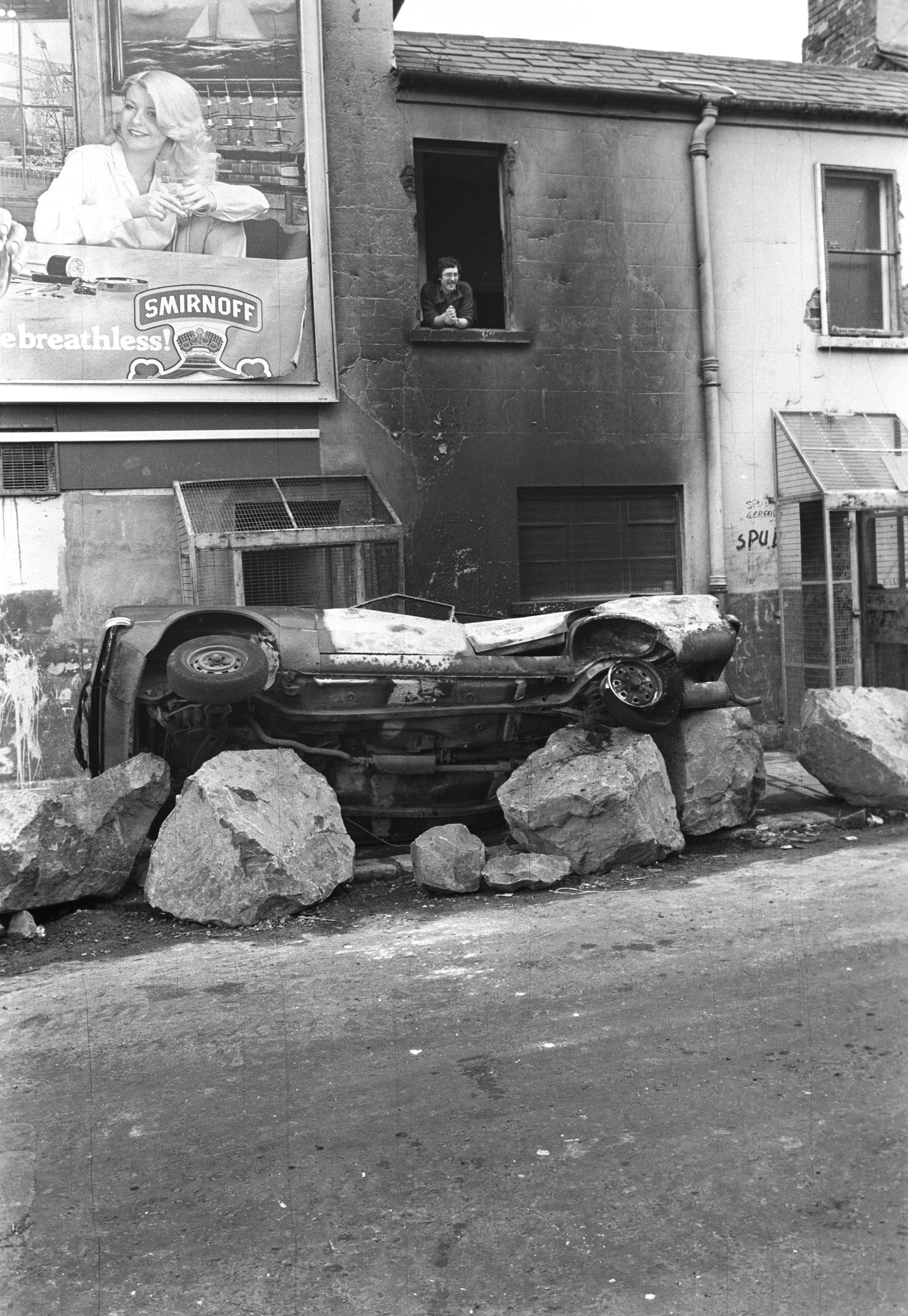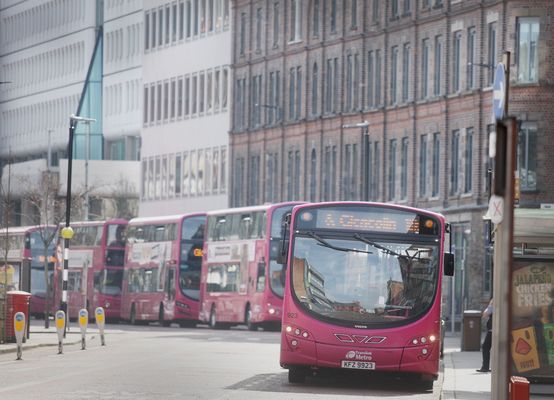A PHOTO can tell a thousand words and can sum up monumental historical events in the capturing of one split second of time. Some photos capture historic moments, and others can help us to better understand those moments.
This photo of Richard McAuley looking out on to Sevastopol Street from Sinn Féin’s offices is one which can help us understand a time in the North which has all but disappeared in recent years.
The picture, which was featured in our August 2, 1980 edition is indicative of the attitude of the British Army at the time towards Irish nationalists. As Richard explained, the burned-out car had been deliberately dumped there by the British Army following rioting on the road in order to inconvenience families who would regularly use that entrance to await transport to visit imprisoned relatives.
Richard remembers: “The offices in Sevastapol Street were a regular target for the British Army, the RUC and loyalists. There had been rioting on the road and the cars had been burned. When the British Army were clearing the debris, they used their heavy bulldozers to lift the car up and dropped it into the gap between the entrance to the office and the big stones.
"That entrance was used by the republican transport service, which was used by families when they were going to visit family members who were in the Blocks, Armagh or Portlaoise prisons. The entrance they blocked was to the room relatives would have used to go in and wait on the minibus to come and pick them up to see their family members. It was a pretty petty and vindictive effort to chose that gate, and was done to annoy families even more.
"It was a regular occurrence for British Army foot patrols to stop outside the building and harass families going in and out, searching their belongings. The office was a regular target for those who didn’t like the party.”
The building pictured here was later demolished and rebuilt from the foundations up and where that gable and window were is now the large mural of Bobby Sands, which has become a major Belfast tourist attraction.
The Sinn Féin offices pictured have seen some of the worst events of the conflict, but were also a place where important decisions were made which have changed the course of history here. The building was targeted, shot at and bombed many times, and was infamously the site of a massacre in 1992 when two party activists and a local man were shot dead and several others wounded by a member of the RUC.
The building was also one of the places where the first foundations of the peace process were laid, where the decision was taken to put Bobby Sands up for election in the Fermanagh and South Tyrone by-election while he was on hunger strike – a seat which he subsequently won. This decision led to Sinn Féin entering the electoral process in the North and culminated in the decision taken at the 1986 Ard Fheis to enter Leinster House, which ultimately caused a split within the party.
Reflecting on the times the building has seen Richard said: “There was a lot of madness happening back then, you can still see we still have little barriers outside the offices, but at that stage it was a much more rough and ready approach. Most of the shops, pubs and clubs at the time had boulders outside their premises to prevent attacks from loyalists putting car bombs outside the building. Although on one occasion Loyalists stopped on the Falls Road late one night in late 1994 and hung a bomb on the grill of a car and it went off without a warning and the shop and a large part of the building were destroyed. Earlier in the year loyalists attacked the building again by firing an RPG and shooting at the building.
"Countless photographs and film footage exist of this particular area where riots, British patrols, checkpoints, burning cars and buses were common. Throughout the conflict those things were a regular occurrence.
"When that photo was taken Sinn Féin hadn’t fought a single election in the North. Now 42 years on from that photo there have been two seismic political events which have happened in 2022 with Sinn Féin becoming the largest party and Michelle O’Neill becoming the First Minister designate, something which the state was deliberately created to prevent from happening, and now we’ve also seen the census figures which have uprooted the whole premise the Northern state was founded on 100 years ago.
“In those offices we sat and discussed, getting Bobby Sands to stand for election in the Fermanagh and South Tyrone by-election, we wanted to raise awareness about the ongoing struggle in the H-Blocks. The building has been through a lot in the years, it was also the place where Pat McBride, Paddy Loughran and Michael O’Dwyer were murdered by a member of the RUC in February 1992.”
The Bobby Sands mural is one of the most recognisable murals in the world.
— Fáilte Feirste Thiar (@FailteFeirste) May 27, 2022
Located in Sevastopol Street next to the Falls Road Library the image depicts a portrait of Bobby Sands with the description 'Our revenge will be the laughter of our children' https://t.co/KV4WhYfwtz pic.twitter.com/cc5qYJan0b
The building as it now stands has become a major tourist attraction for visitors keen to learn of the history of the conflict in the North and the mural is also guaranteed to have visitors to the city posing for photographs beside the image of Bobby Sands.
Speaking on the importance of the mural, Richard said it can sometimes feel surreal to see so many people standing outside hearing about the history of the conflict, but it is also shows the impact that activists like Bobby Sands and their struggle have had on the history of Belfast, and also on the world.
“The Bobby Sands mural has become an iconic image. Every day outside these offices there are tourists giving Black Taxi Tours, and at times I find it surreal. There are days when people can’t park because there are so many people there to see the mural. On days when the window is open all you hear is loads of different voices telling the story of Bobby Sands. The tours also let people learn about other people who are commemorated by our offices such as Máire Drumm and Pat ‘Beag’ McGeown.
"In its own way it’s a measure of how profound an effect events like the hunger strikes have had, and continue to have. I don’t think any of us imagined how big an attraction the mural would become for people to come and learn about the conflict.”
The first mural on the wall was of a crowd people reading An Phoblacht and it was later replaced with the mural of Bobby Sands in 1998.







